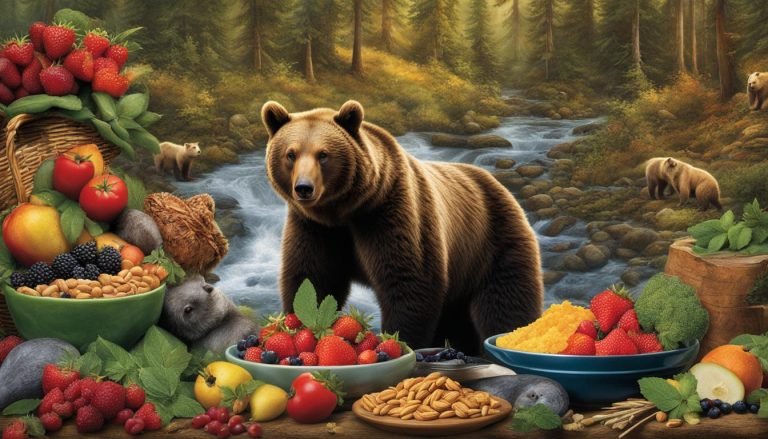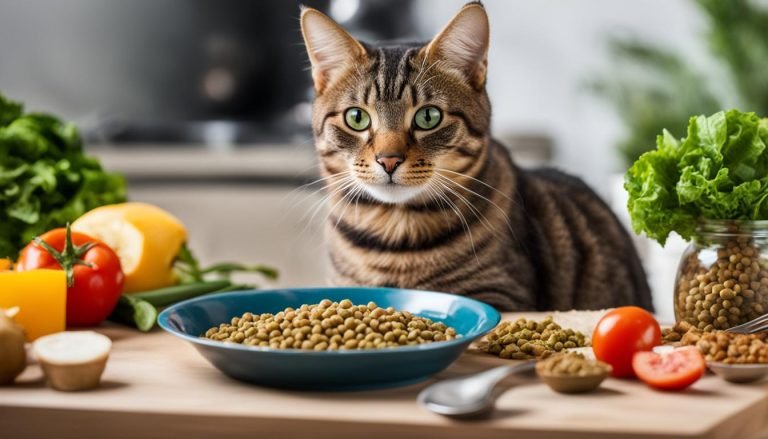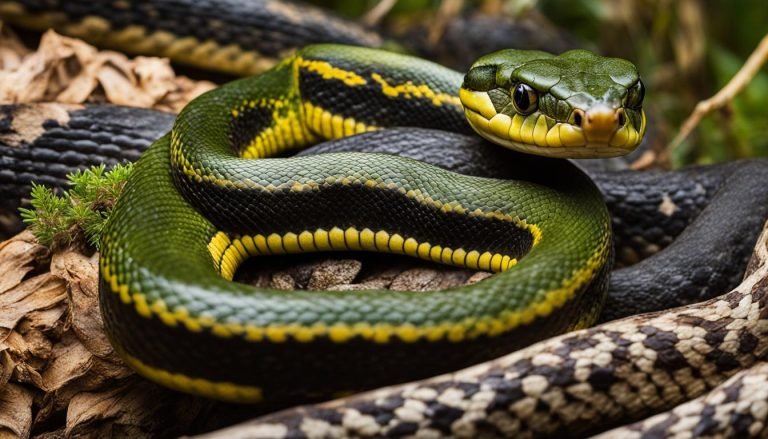What Do Elephants Eat?
Elephants are majestic creatures but have you ever wondered, what do elephants eat?
In this guide, I will take you through the exciting world of elephants’ diets, their feeding behavior, and the factors that influence their food preferences.
As herbivores, elephants rely solely on plant-based food for their sustenance. Their food habits are unique and complex, and we will explore them in detail in the following sections.
Elephant Quiz
How well do you know elephants? Test your knowledge here!


Key Takeaways:
- Elephants are herbivores and rely solely on plant-based food.
- In this guide, we will explore elephants’ feeding behavior, natural diet, herbivorous eating patterns, food preferences, and the factors that influence their food choices.
Understanding Elephant Feeding Behavior
Elephants are fascinating creatures, and their feeding behavior is no exception. As herbivores, they consume a plant-based diet, which means their food habits must adapt to their environment.
When it comes to the food habits of elephants, several factors influence their feeding behavior, including:
- The availability of food
- The availability of water
- The season
- Their age and sex
These factors shape an elephant’s diet and help them make adaptive feeding decisions. For instance, during the dry season, elephants may travel great distances to find water and food sources, whereas during the wet season, food and water may be more abundant.
Food Habits of Elephants
Elephants are selective feeders, which means they do not eat every type of plant. They can consume up to 330 pounds of food per day, with their diet consisting of a variety of vegetation, including:
| Types of Vegetation | Examples |
|---|---|
| Leaves | Acacia, fig, and baobab leaves |
| Grasses and herbs | Bamboo shoots, orchard grass, and buffalo grass |
| Wild fruits and berries | Marula, wild mango, and jackalberry |
| Bark and wood | Acacia, mopane, and marula bark |
| Roots, bulbs, and tubers | Wild ginger, sweet potato, and water lily bulbs |
An elephant’s feeding behavior typically involves grazing and browsing. Grazing involves consuming grass and other low-lying vegetation, while browsing involves consuming leaves and branches from trees and shrubs. Elephants can also uproot entire trees to access their leaves, bark, and wood.
Elephant Feeding Behavior
Elephants have a unique feeding behavior that is shaped by their herbivorous diet. They are known to consume large volumes of food, and up to 50 gallons of water in a single day.
An elephant’s feeding behavior can be broken down into three stages:
- Selection: During this stage, elephants use their sense of smell and touch to identify food sources.
- Manipulation: Once they have identified their food source, they use their trunk to manipulate it into their mouth.
- Ingestion: After manipulation, the food is ingested and passed through the digestive system, where it is broken down and absorbed for nutrients.
Their enormous size and unique feeding behavior contribute to their importance in maintaining the ecosystems they inhabit. By consuming vegetation, they help to regulate plant growth and disperse seeds through their droppings, supporting the biodiversity of their habitats.

Elephants’ Natural Diet in the Wild
Elephants are known to have a diverse and plant-based diet in their natural habitat. They mainly consume leaves, grasses, fruits, bark, and roots, depending on the season and availability of vegetation in the area. While their diet may vary across different regions, research suggests that elephants feed on over 100 plant species.
Leaves constitute a significant portion of an elephant’s diet, with some studies estimating that they consume over 150 kgs of leaves per day. They primarily feed on young, tender leaves, which are high in nutrients and easy to digest. Grasses also form a substantial part of their diet, especially during the rainy season, when grasses are abundant.
As fruits are seasonal, elephants will consume them when available. They prefer fruits that are highly nutritious, such as baobab and wild date palms. Bark and twigs are another food source for elephants, which helps in wearing down their teeth, which continuously grow throughout their lifetime.
Moreover, water plays a crucial role in an elephant’s diet. Elephants drink large amounts of water and need to hydrate themselves regularly. They also rely on water sources for bathing and cooling their bodies.
The Role of Body Size in Elephants’ Diet
Their large body size significantly influences the quantity and types of food they consume. Adult elephants require a massive amount of food to meet their energy demands, which can be up to 300 kgs per day! Therefore, elephants’ diet has a considerable impact on the vegetation’s productivity, which can lead to conflicts with local communities and other animals.
However, elephants also play a vital role as ecosystem engineers, maintaining the balance of their environment. They help in shaping the vegetation by uprooting and breaking branches, allowing for new growth and dispersing seeds through their dung.
“Elephants have a diverse and plant-based diet in their natural habitat, consuming leaves, grasses, fruits, bark, and roots.”
In conclusion, elephants have a unique and fascinating diet that plays a crucial role in their survival and the ecosystem they inhabit. Their preference for specific vegetation helps shape the environment in which they live, while also providing important ecological services to other organisms. Understanding their natural diet is essential for conservation efforts and ensuring their long-term survival in the wild.
Herbivorous Eating Patterns of Elephants
Elephants are unique herbivores with distinct grazing habits and feeding patterns. Their large size requires that they consume a significant volume of food daily, and their digestive system is designed to handle the fibrous plant material effectively. In this section, we will examine the eating patterns of elephants and how they contribute to their overall health and nutrition.
Grazing Habits
Elephants are grazers, which means they feed on vegetation growing low to the ground. They use their trunks to uproot vegetation and strip leaves from trees and shrubs. When grazing, elephants tend to move slowly, taking their time to carefully select the plants they prefer. They are known to push aside less desirable vegetation to get to the leaves they want, using their tusks and trunks to rip and tear at the preferred leaves.
Feeding Duration
Elephants have a slow feeding rate, and they can spend up to 18 hours a day foraging for food. Due to their large size, they need to consume a lot of food to sustain their energy levels, which makes their feeding duration exceptionally long.
The volume of Food Consumed Daily
Elephants are known for being one of the largest land mammals, and the amount of food they consume is staggering. On average, an adult elephant can eat up to 300 pounds (136 kilograms) of vegetation in a single day. This volume of food is necessary to fuel their massive bodies and maintain their overall health.

“Elephants are known for being one of the largest land mammals, and the amount of food they consume is staggering.”
It’s essential to note that the volume of food consumed also depends on the size, age, and sex of the elephant. For instance, adult males tend to consume more food than their female counterparts, while older elephants generally eat less but take longer to forage for food.
Factors Affecting Herbivorous Eating Patterns
The herbivorous eating patterns of elephants can be influenced by various factors, including:
- The availability and quality of vegetation in their habitat
- The season and climate
- Their age, sex, and reproductive status
- The presence of predators or other threats
Adaptive feeding behaviors are essential for elephants to survive in their natural habitats. These behaviors include selecting food items based on their nutritional content, adapting their grazing patterns to avoid overgrazing, and altering their migratory patterns in response to changing food availability. Understanding these patterns is crucial for conservation efforts and ensuring the long-term survival of these magnificent creatures.
Elephant Food Preference
Elephants may consume a variety of plant-based foods, but they have specific preferences when it comes to their diet.
One of their favorite food sources is the leaves of trees and shrubs. This is especially true for the African elephant, which feeds on mopane trees in the savannas and acacia trees in the woodlands. Asian elephants, on the other hand, are known to prefer the leaves of bamboo and banana plants.
Elephants are also fond of fruits and berries, which provide a natural source of sugar. They often raid crops such as bananas, pineapples, and sugarcane, causing problems for farmers in areas where they coexist.
In contrast, elephants don’t have a taste for all plant-based foods. For example, they avoid certain types of grasses that lack nutritional value and have tough fibers. They also tend to steer clear of poisonous plants like the milkweed.
Another interesting fact about elephant food preference involves their sense of smell. Elephants have an excellent sense of smell, and they can sniff out food from several miles away. They are attracted to the aroma of ripe fruits and fresh vegetation, which explains why they sometimes destroy crops to obtain them.
“Although they are known to raid crops and destroy gardens, elephants play a vital role in maintaining the ecosystem by dispersing seeds and creating pathways in dense forests.”
Factors Influencing Elephant Diet
Several factors can influence an elephant’s diet, including age, season, and habitat. As elephants grow, their dietary needs change, leading to a shift in their food preferences. For instance, young elephants rely heavily on their mother’s milk for the first few months of their lives; then, they gradually start to consume solid food. As they age, their digestive tracts become better adapted to their herbivorous diet, enabling them to consume tougher plant materials.
The season also plays a role in elephants’ food habits. During the dry season, food scarcity leads elephants to migrate in search of greener pastures. In contrast, during the rainy season, elephants tend to stay in one area where food is abundant.
Finally, habitat influences what elephants eat. Depending on the vegetation type in their habitat, elephants may have a preference for certain plant species. For example, elephants living in forested areas consume more foliage and bark than those living in savannas.
Overall, understanding the factors that influence the elephant diet is essential in developing conservation strategies that cater to their specific dietary needs.
Fascinating Elephant Trivia
As we conclude our guide on the diet of elephants, let’s dive into some intriguing trivia about their food habits.
Did you know?
Elephants have a unique feeding behavior where they use their long trunks to pick leaves and place them in their mouths. They can consume up to 300 pounds of vegetation a day!
Favorite Foods
Elephants have a definite preference when it comes to their food. Their favorite plants include acacia, baobab, and marula trees, as well as certain types of grasses and fruits.
Human Interference
Human activities such as deforestation and poaching have adverse effects on elephant feeding behavior. These activities can result in the loss of natural vegetation, which can lead to a decline in the elephant population.
Food vs. Water
Elephants require large amounts of water to survive, and their daily water intake can sometimes exceed their food intake. The average adult elephant can consume up to 50 gallons of water a day, depending on the season and availability of water sources.
Adaptive Behavior
Elephants are capable of adapting their feeding behavior to their surroundings. For example, during the dry season when food is scarce, they can resort to eating bark and roots to survive.
There you have it, some fascinating trivia about elephants’ feeding behavior and food preferences. Their herbivorous diet is vital to their survival and plays a crucial role in maintaining the balance of their ecosystem.
More About Elephants:
- How Do Elephants Mate?
- How Long Do Elephants Live? Detailed Lifespan Guide
- 15 Facts About Elephants That Will Shock You
- Elephant Quiz: How Well Do You Know Elephants?
Frequently Asked Questions
What do elephants eat?
Elephants primarily eat vegetation such as leaves, grasses, fruits, bark, and roots.
What influences elephant food preferences?
Factors such as age, season, and habitat can influence what elephants choose to eat.
Do elephants have specific eating patterns?
Yes, elephants have unique grazing habits, feeding duration, and daily food intake volume.
Why do elephants prefer certain plants over others?
Elephants have food preferences based on the taste, texture, and nutritional value of plants.
How does human interference impact elephant food choices?
Human interference can disrupt natural food sources for elephants, affecting their food choices.
What is the natural diet of elephants in the wild?
Elephants in the wild consume a diverse range of vegetation including leaves, grasses, fruits, bark, and roots.
Why is water important in an elephant’s diet?
Elephants need water to hydrate and aid in digestion.
What are some fascinating facts about elephant feeding behavior?
Elephants spend a significant amount of time feeding, with adults consuming up to 300 pounds of food per day.
How do elephants adapt their diet in different habitats?
Elephants adapt their diet to the vegetation available in their specific habitat, ensuring their nutritional needs are met.
Do elephants have any unique food preferences?
Elephants have been observed displaying a liking for certain types of fruits and specific tree species.







